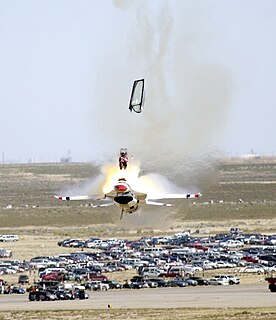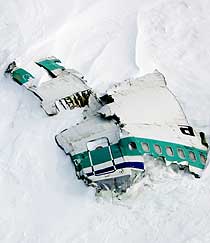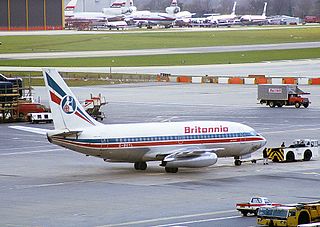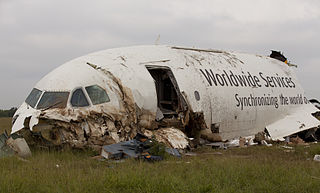Related Research Articles

A pitottube, also known as pitot probe, is a flow measurement device used to measure fluid flow velocity. The pitot tube was invented by the French engineer Henri Pitot in the early 18th century and was modified to its modern form in the mid-19th century by French scientist Henry Darcy. It is widely used to determine the airspeed of an aircraft, water speed of a boat, and to measure liquid, air and gas flow velocities in certain industrial applications.

An aviation accident is defined by the Convention on International Civil Aviation Annex 13 as an occurrence associated with the operation of an aircraft, which takes place from the time any person boards the aircraft with the intention of flight until all such persons have disembarked, and in which a) a person is fatally or seriously injured, b) the aircraft sustains significant damage or structural failure, or c) the aircraft goes missing or becomes completely inaccessible. Annex 13 defines an aviation incident as an occurrence, other than an accident, associated with the operation of an aircraft that affects or could affect the safety of operation.

Avianca Flight 410 was a flight that crashed at 13:17 on March 17, 1988, near Cúcuta, Colombia, that occurred shortly after takeoff when it flew into a mountain. All 143 people on board were killed. It was the deadliest aviation accident to occur in Colombia at the time.

American Airlines Flight 965 was a regularly scheduled flight from Miami International Airport in Miami, Florida, to Alfonso Bonilla Aragón International Airport in Cali, Colombia. On December 20, 1995, the Boeing 757-200 flying this route crashed into a mountain in Buga, Colombia, killing 151 out of the 155 passengers and all eight crew members.

A controlled flight into terrain is an accident in which an airworthy aircraft, under pilot control, is unintentionally flown into the ground, a mountain, a body of water or an obstacle. In a typical CFIT scenario, the crew is unaware of the impending disaster until it is too late. The term was coined by engineers at Boeing in the late 1970s.

Aviation safety means the state of an aviation system or organization in which risks associated with aviation activities, related to, or in direct support of the operation of aircraft, are reduced and controlled to an acceptable level. It encompasses the theory, practice, investigation, and categorization of flight failures, and the prevention of such failures through regulation, education, and training. It can also be applied in the context of campaigns that inform the public as to the safety of air travel.

Avianca Flight 011, registration HK-2910X, was a Boeing 747-200B on an international scheduled passenger flight from Frankfurt via Paris, Madrid, and Caracas to Bogotá, Colombia that crashed on 27 November 1983. It took off from Charles de Gaulle Airport in Paris at 22:25 on 26 November 1983 for Madrid Barajas Airport; take-off was delayed waiting for additional passengers from a Lufthansa flight due to a cancellation of the Paris-Frankfurt-Paris segment by Avianca for operational reasons.

USAir Flight 405 was a regularly scheduled domestic passenger flight between LaGuardia Airport in Queens, New York City, New York, and Cleveland, Ohio. On March 22, 1992, a USAir Fokker F28, registration N485US, flying the route, crashed in poor weather in a partially inverted position in Flushing Bay, shortly after liftoff from LaGuardia. The undercarriage lifted off from the runway; however, the airplane failed to gain lift, flying only several meters above the ground. The aircraft then veered off the runway and hit multiple obstructions before coming to rest in Flushing Bay, just beyond the end of the runway. Of the 51 people on board, 27 were killed, including the captain and a member of the cabin crew.

American Airlines Flight 625, a Boeing 727-100, crashed at St. Thomas, U.S. Virgin Islands on April 27, 1976, while on a domestic scheduled passenger flight originating at T. F. Green Airport in Rhode Island and ending at Saint Thomas, United States Virgin Islands, with an intermediate stop at John F. Kennedy International Airport. 37 out of the 88 passengers on board died in the accident.

A pitot-static system is a system of pressure-sensitive instruments that is most often used in aviation to determine an aircraft's airspeed, Mach number, altitude, and altitude trend. A pitot-static system generally consists of a pitot tube, a static port, and the pitot-static instruments. Other instruments that might be connected are air data computers, flight data recorders, altitude encoders, cabin pressurization controllers, and various airspeed switches. Errors in pitot-static system readings can be extremely dangerous as the information obtained from the pitot static system, such as altitude, is potentially safety-critical. Several commercial airline disasters have been traced to a failure of the pitot-static system.

Historically, the term pilot error has been used to describe an accident in which an action or decision made by the pilot was the cause or a contributing factor that led to the accident, but also includes the pilot's failure to make a correct decision or take proper action. Errors are intentional actions that fail to achieve their intended outcomes. Chicago Convention defines accident as "An occurrence associated with the operation of an aircraft [...] in which [...] a person is fatally or seriously injured [...] except when the injuries are [...] inflicted by other persons." Hence the definition of the "pilot error" does not include deliberate crash.

Copa Airlines Flight 201 was a regularly scheduled passenger flight from Tocumen International Airport in Panama City, Panama to Alfonso Bonilla Aragón International Airport in Cali, Colombia. On 6 June 1992, the Boeing 737-204 Advanced operating the route rolled, entered a steep dive, then disintegrated in mid-air, and crashed into the jungle of the Darién Gap 29 minutes after takeoff, killing all 47 people on board. The in-flight break-up was caused by faulty instrument readings and several other contributing factors, including incomplete training.

On October 10, 1933, a Boeing 247 airliner operated by United Airlines and registered as NC13304 crashed near Chesterton, Indiana. The transcontinental flight carried three crew and four passengers and originated in Newark, New Jersey, with its final destination in Oakland, California. It had already landed in Cleveland and was headed to its next stop in Chicago when it exploded en route. All aboard died in the crash, which was caused by an on-board explosive device. Eyewitnesses on the ground reported hearing an explosion shortly after 9 p.m. and seeing the aircraft in flames at an altitude of about 1,000 feet (300 m). A second explosion followed after the aircraft crashed. The crash scene was adjacent to a gravel road about 5 miles (8 km) outside of Chesterton, centered in a wooded area on the Jackson Township farm of James Smiley.

Birgenair Flight 301 was a flight chartered by Turkish-managed Birgenair partner Alas Nacionales from Puerto Plata in the Dominican Republic to Frankfurt, Germany, via Gander, Canada, and Berlin, Germany. On 6 February 1996, the 757-200 operating the route crashed shortly after take-off from Puerto Plata's Gregorio Luperón International Airport. All 189 people on board died. The cause was pilot error after receiving incorrect airspeed information from one of the pitot tubes, which investigators believe was blocked by a wasp nest built inside it. The aircraft had been sitting unused for 20 days, and without pitot tube covers in place for the preceding 2 days before the crash.

Gol Transportes Aéreos Flight 1907 was a Boeing 737-8EH on a scheduled domestic passenger flight from Manaus, Brazil, to Rio de Janeiro. On the afternoon of 29 September 2006, it collided in mid-air with an Embraer Legacy 600 business jet over the Brazilian state of Mato Grosso. The Boeing 737 broke up in mid-air and crashed into an area of dense jungle, killing all 154 passengers and crew on board. Despite sustaining serious damage to its left wing and tail, the Embraer Legacy jet landed safely with its seven occupants uninjured.
A chain of events is a number of actions and their effects that are contiguous and linked together that results in a particular outcome. In the physical sciences, chain reactions are a primary example.

The 1958 Central African Airways plane crash occurred when a Vickers Viscount airliner crashed during a scheduled passenger flight from Wadi Halfa, Sudan, to Benghazi, Libya, on 9 August 1958 about nine kilometers southeast of Benina International Airport in Libya. A total of forty-seven passengers and seven crew members were on board of whom only eighteen survived, making it the deadliest ever plane crash in Libya at the time of the accident.

UPS Airlines Flight 1354 was a scheduled cargo flight from Louisville, Kentucky, to Birmingham, Alabama. On August 14, 2013, the Airbus A300 flying the route crashed and burst into flames short of the runway on approach to Birmingham–Shuttlesworth International Airport. Both pilots were pronounced dead at the scene of the crash. They were the only people aboard the aircraft.

Cubana de Aviación Flight 972 was a scheduled domestic flight from José Martí International Airport, Havana, Cuba, to Frank País Airport in Holguín, Cuba. On May 18, 2018, the 39-year-old Boeing 737-201 Adv. operating the route crashed shortly after takeoff, near Santiago de las Vegas, 19 kilometres from Havana city centre. Of those on board, 112 died and one passenger survived with critical injuries. There were initially four survivors, but three of them later died at a local hospital. Most of the passengers on board were Cuban nationals, although the crew was entirely Mexican.

In March 2019, the Boeing 737 MAX passenger airliner was grounded worldwide after 346 people died in two crashes, Lion Air Flight 610 on October 29, 2018 and Ethiopian Airlines Flight 302 on March 10, 2019. Ethiopian Airlines immediately grounded its remaining MAX fleet. On March 11, the Civil Aviation Administration of China ordered the first nationwide grounding, followed by most other aviation authorities in quick succession. The U.S. Federal Aviation Administration (FAA) publicly affirmed the airworthiness of the airplane on March 11, but grounded it on March 13 after receiving evidence of accident similarities. All 387 aircraft, which served 8,600 flights per week for 59 airlines, were barred from service by March 18, 2019. The groundings became the longest ever of a U.S. airliner.
References
- 1 2 Willits, Pat (2007). Guided Flight Discovery: Private Pilot. Mike Abbott and Liz Kailey. Englewood: Jeppesen. pp. 10–26. ISBN 978-0-88487-429-4. OCLC 145504766. Archived from the original on 2007-10-11. Retrieved 2007-08-07.
- ↑ Gertler, Judith B. (11 March 2018). "Improving Safety-related Rules Compliance in the Public Transportation Industry". Transportation Research Board – via Google Books.
- ↑ "International Conference on Social, Education and Management Engineering". DEStech Publications, Inc. 9 July 2014 – via Google Books.
- ↑ Reese, Charles D. (25 October 2011). "Accident/Incident Prevention Techniques, Second Edition". CRC Press – via Google Books.
- ↑ Consulting, In c ABS (1 February 2002). "Principles of Risk-Based Decision Making". Government Institutes – via Google Books.
- ↑ Stellman, Jeanne Mager (11 March 1998). "Encyclopaedia of Occupational Health and Safety". International Labour Organization – via Google Books.
- ↑ Willits, Pat (2000). Guided Flight Discovery: Instrument/Commercial. Mike Abbott, Liz Kailey, and Jim Mowery. Englewood: Jeppesen. pp. 1–31. ISBN 0-88487-274-2. OCLC 145504766.[ permanent dead link ]
- ↑ Boeing (2016). "Statistical Summary of Commercial Jet Airplane Accidents Worldwide Operations" (PDF). Aviation Safety Boeing Commercial Airplanes.
- 1 2 "The Deadliest Plane Crash (transcript)". NOVA. PBS. 2006.
| This aviation-related article is a stub. You can help Wikipedia by expanding it. |